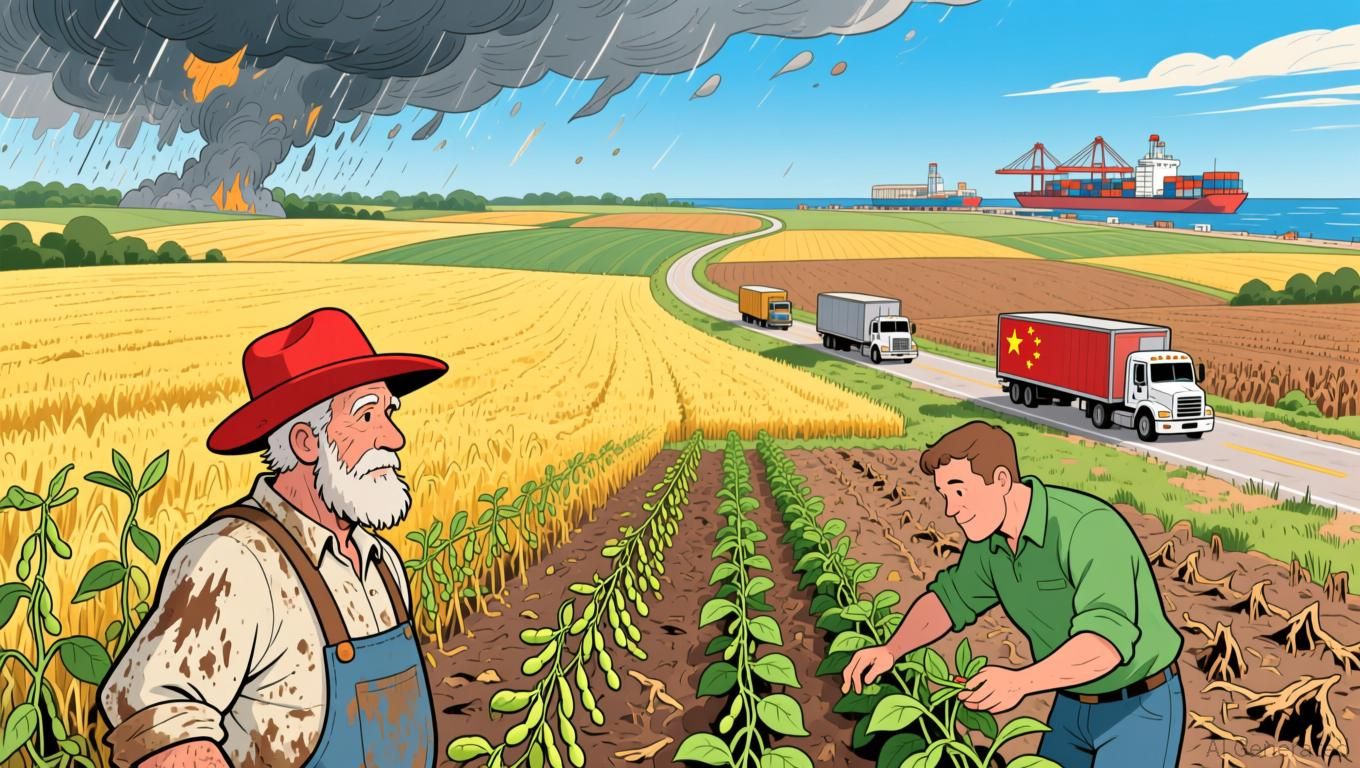China’s Influence on Soybean Trade and a Failing System Push U.S. Farmers into Turmoil
- U.S. rural farmers face crisis as China's reduced soybean purchases and trade disputes drive plummeting prices and high debt. - Federal aid programs provide short-term relief but fail to address systemic issues like inflated land prices and structural profitability gaps. - Trump's trade policy adjustments offer mixed signals, temporarily easing tariffs on imports while China maintains residual soybean duties as geopolitical leverage. - Record farm debt and grocery insecurity highlight a K-shaped recovery
The agricultural economy in rural America is experiencing an uneven recovery, with government assistance reaching emergency levels as ongoing trade conflicts and deep-rooted challenges widen the gap between struggling farmers and more stable agricultural sectors. The situation has worsened due to China's ongoing hesitation to resume significant U.S. soybean imports, leaving farmers in the Midwest facing falling prices, rising production expenses, and unpredictable trade regulations. Meanwhile,
The trade standoff over soybeans between the U.S. and China has become a central issue in the economic hardships facing rural communities. Since October 2025, China has committed to buying 12 million metric tons of U.S. soybeans—less than half of the 26.8 million metric tons it imported in 2024. This gap has left Wisconsin's soybean farmers—whose industry is worth $1.3 billion a year—dealing with losses as global prices drop. "The unpredictability of trade policy has added more pressure on farmers who are already struggling to make future plans," stated Paul Mitchell, an agricultural economics professor at the University of Wisconsin-Madison

The federal response has included emergency support, such as $30 billion in relief for Emergency Commodity Assistance and Supplemental Disaster Relief programs. Still, critics argue these efforts fall short, often driving up land values instead of improving farm profitability. "Farmers are stuck in a dysfunctional system," said Joe Maxwell from Action Farm Fund, a farmer advocacy group. "We keep spending on temporary solutions while the core issues in agriculture remain unaddressed"
Recent changes in trade policy under President Donald Trump have sent mixed messages. On November 13, Trump issued an executive order that exempts major agricultural imports—such as Indian spices, coffee, and tropical fruits—from a 50% tariff increase, citing concerns over rising domestic prices. This move, part of broader trade talks, is intended to lower food costs for Americans and reduce pressure on importers. In a separate agreement, China has paused retaliatory tariffs on U.S. soybeans in return for reduced U.S. tariffs, though a 13% duty still applies
The pronounced split in the farm economy underscores the vulnerability of rural livelihoods. While large agribusinesses and major producers are able to adjust to changing trade conditions, smaller farms are facing severe risks. The latest figures from the Federal Reserve indicate that farm debt has hit unprecedented levels, with
Disclaimer: The content of this article solely reflects the author's opinion and does not represent the platform in any capacity. This article is not intended to serve as a reference for making investment decisions.
You may also like
XRP News Today: Federal Uncertainty and Worldwide Regulations Trigger $1 Trillion Crypto Market Crash
- Bitcoin fell below $92,000, erasing $1 trillion in crypto value as major altcoins faced double-digit weekly losses. - Fed rate cut uncertainty and Japan's regulatory scrutiny intensified selling, with analysts warning of further declines to $80,000–$86,000. - XRP's 14% drop and whale-driven selling pressured prices, though new ETFs sparked speculation about potential rebounds to $2.75.

XRP News Today: Launch of XRP ETF Unable to Halt Price Drop Amid Strong Selling Pressure
- Bitcoin fell below $93,000, erasing 2025 gains amid a broader crypto selloff, with XRP dropping 7% despite a new ETF's debut. - XRPC ETF generated $58.6M in volume but failed to sustain momentum, highlighting fragile risk appetite amid macroeconomic uncertainty. - XRP's price collapse triggered $28M in liquidations and 342% trading volume spikes, with on-chain data showing 110.5M tokens moved during the selloff. - Technical indicators showed bearish signals for Bitcoin and Ethereum , while market partici

Alibaba and JPMorgan Disrupt Conventional Banking with Real-Time Blockchain Transactions
- Alibaba and JPMorgan launch blockchain-based tokenized payments by 2025 to streamline cross-border B2B transactions, bypassing intermediaries. - The system tokenizes USD and EUR deposits via JPMorgan's Kinexys platform, enabling instant settlements and reducing reliance on traditional banking networks. - AI tools like Agentic Pay and AI Mode will automate contracts and supplier comparisons, enhancing global supply chain efficiency. - The initiative aligns with industry trends in tokenization, potentially

XLM Price Prediction: The Key Levels to Watch for 2026 as EV2 Becomes the Hottest Presale of the Year
